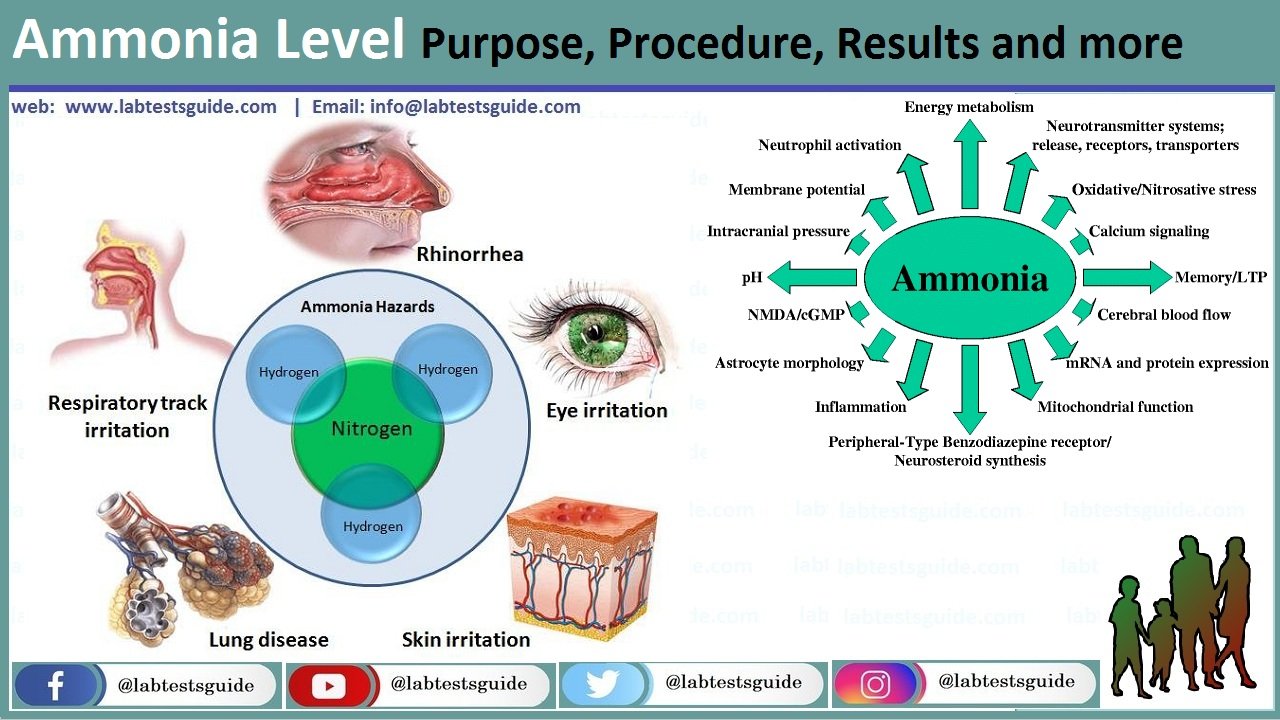Ammonia is a nitrogen waste compound that is normally excreted in the urine. An elevated level of ammonia in the blood is an excessive accumulation of ammonia in the blood. An elevated level of ammonia in the blood occurs when the kidneys or liver are not working properly, allowing wastes to remain in the bloodstream. Ammonia, like many other waste products in the body, can be poisonous to cells, and a high level of ammonia in the blood can affect the entire body.

Also Known As: NH3m, Ammonia Level, Serum Ammonia, Plasma Ammonia, Ammonia
Purpose:
- To find the progression of liver disease and its response to treatment (Fulminant hepatitis or cirrhosis).
- To diagnose Reye’s syndrome.
- To follow the hepatic encephalopathy.
- In the case of a patient with hyperalimentation, taking high calorie I/V nutrition.
- The advice in the newborn when the infant has irritability, vomiting, lethargy, and develops seizures in the early days of birth.
Why Get Tested?
To detect an elevated level of ammonia in the blood that may be caused by severe liver disease, kidney failure, or certain rare genetic disorders; to help investigate the cause of changes in behavior and consciousness; to help diagnose hepatic encephalopathy or Reye syndrome
When To Get Tested?
When someone with or without liver disease or kidney failure experiences mental changes or lapses into a coma; when a newborn experiences frequent vomiting and increased lethargy or when a child has continuous vomiting and unusual sleepiness during recovery from a viral illness, such as the flu or chickenpox
Signs And Symptoms Of Hyperammonemia:
- Hyperammonemia exerts toxic effects on the central nervous system.
- Causes may be:
- Inherited. There is a deficiency of the urea cycle enzyme, common in infants.
- Acquired. The causes are liver diseases and renal failure.
- There is fatigue.
- There is a loss of appetite.
- There are nausea and vomiting.
- There is a loss of strength.
- Ultimately patient will have confusion.
- The patient may have pain abdomen or back.
- Precipitating causes of encephalopathy are:
- Dietary protein.
- Constipation.
- Drugs.
- Infection.
- Electrolytes and acid-base imbalance.
Common symptoms of elevated blood ammonia level:
Symptoms of elevated blood ammonia can occur frequently, even daily, or just occasionally. At times, any of these symptoms can be severe:
- Confusion
- Fatigue
- Loss of appetite
- Nausea with or without vomiting
- Pain in the back, sides or abdomen
- Weakness (loss of strength)
Sample Required:
- Whole blood is needed for the estimation of Ammonia.
- Plasma is prepared in EDTA or heparin other than ammonium heparinate.
- Fasting AM samples are preferred.
- There should be no smoking after 12 midnight.
- Avoid smoking in the vicinity of the test sample place.
- There should be no clinching of the hand.
- Ammonia is volatile gas so it should be transported in ice or test immediately.
- The specimen may be centrifuged at 4 °C.
- Perform the test within 20 minutes or freeze the plasma immediately.
- Urine 24 hours sample is preferred.
Sampling Precautions:
- Analyze the sample as soon as possible.
- Avoid hemolyzed sample, it increases the ammonia level because the RBCs contains more three times than plasma.
- Avoid clenching of the fist.
- Avoid exercise before taking the blood sample because it increases the level.
- Don’t smoke at least 8 hours prior to this test.
- One cigarette smoked one hour before the sample can raise the blood ammonia concentration to 100 to 200 µg/L.
- Smokers need a shower and new clothing.
- The technician should also be a non-smoker.
- Use of the tourniquet may increase the ammonia level.
- Avoid contamination of urine by bacteria or ammonia.
- Glassware should be clean and wash with a hypochlorite solution.
- EDTA and heparin are acceptable anticoagulants.
- The arterial blood sample is more reliable than venous but difficult to obtain, so venous blood is taken.
- Drugs that increase the level are:
- Acetazolamide.
- Alcohol.
- Barbiturates.
- Ammonium chloride.
- Narcotics.
- Parenteral nutrition.
- Diuretics.
- Drugs that decrease the level are:
- Broad-spectrum antibiotics (neomycin).
- Levodopa.
- Potassium salt.
- Lactobacillus.
Normal Values:
Source 2
- Adult = 10 to 80 µg /dL
- Child = 40 to 80 µg /dL
- Newborn = 90 to 150 µg /dL
Other reference
- Normal range = 19 to 60 µg /dL
- Urine = 140 to 1500 µg /dL
Another source
- 19 to 60 µg NH3 /dL (by Du Pont automated clinical analyzer)
- By Ektachem:
- 0 to 10 days = 170 to 341 µg NH3 /dL
- 10 days to 2 years = 68 to 136 µg NH3 /dL
- > 2 years = 19 to 60 µg NH3 /dL
Another source
- Adult = 15 to 56 µg /dL
- Birth to 10 days =109 to 182 µg /dL
- 10 days to 2 years = 95 to 157 µg /dL
- Children = 36 to 85 µg /dL
Increased Serum Ammonia:
- Hepatic failure
- Hepatic Encephalopathy
- Cirrhosis
- Reye’s Syndrome
- Portacaval shunt
- Medications
- Diuretics
- Polymixin B
- Methicillin
Decreased Serum Ammonia:
- Renal Failure
- Medications
- Neomycin
- Lactulose
- Tetracycline
Possible References Used



